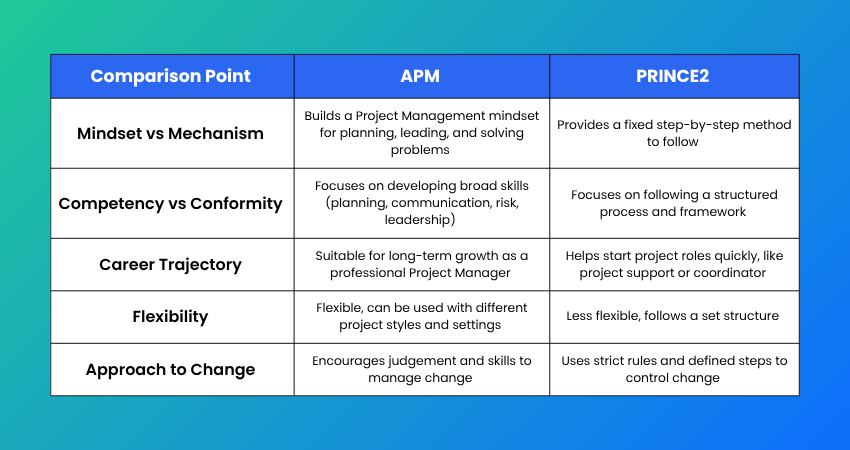

James Smith
Every great Project Manager starts somewhere, and choosing the right qualification is one of the first big steps. If you are here, you are already thinking about your future and deciding whether PRINCE2 or APM suits you. Many successful professionals once felt the same way when choosing between PRINCE2 vs APM, and you are in that same place now. You do not have to decide on your own.
This blog explains APM and PRINCE2, their key differences, and the benefits and drawbacks of each. By the end, you will clearly understand the PRINCE2 vs APM choice and know which option fits your goals and learning style.
Table of Contents
1) What is PRINCE2?
2) What is APM?
3) What is the Difference Between APM vs PRINCE2?
4) What are the Benefits and Drawbacks of PRINCE2?
5) What are the Benefits and Drawbacks of APM?
6) Conclusion
What is PRINCE2?
PRINCE2 stands for Projects IN Controlled Environments. It is a widely recognised Project Management methodology that provides a structured and systematic approach to delivering projects. It focuses on planning, control, and meeting deadlines, budgets, and scope. Created on seven principles, seven themes, and seven processes, it offers defined steps and roles to guide a project from start to finish.
Many organisations prefer PRINCE2 because it brings consistency, organisation, and strong governance. It is commonly used in government, IT, construction, and large organisations, and can be tailored to suit different project needs.
Features of PRINCE2
Here are the main features of PRINCE2:
a) It follows a step-by-step process driven approach
b) Defines clear roles and responsibilities
c) Uses structured documentation and reporting to track progress
d) Focuses on detailed planning and tight control
e) Works effectively for large or complex projects
f) Offers two main certification levels: PRINCE2® Foundation and PRINCE2® Practitioner
PRINCE2 helps people work in a very structured way. If you like clear rules, set plans, and detailed guidance, PRINCE2 may be right for you.
What is APM?
APM stands for Association for Project Management. It is a professional body in the UK that promotes excellence in Project Management through education, standards, and certification. Unlike PRINCE2, APM does not prescribe a single method. Instead, it helps you build a broad and adaptable understanding of Project Management practices.
It focuses on developing the skills, behaviours, and knowledge that help you handle many different types of projects. APM qualifications are recognised across industries such as engineering, technology, business services, and the public sector, making them valuable for career growth.
Features of APM
Here are the main features of APM:
a) Focuses on practical skills and professional knowledge
b) Provides a wide understanding of Project Management principles
c) Emphasises people, teamwork, and leadership skills
d) Applies to many types of projects and industries
e) Supports career progression for Project Managers at all levels
f) Offers multiple certification stages, from beginner (APM Introductory Certificate PFQ) to advanced (APM PMQ)
APM is good if you want a flexible learning path and want to understand the full field of Project Management.
What is the Difference Between APM vs PRINCE2?
Both PRINCE2 and APM are valuable, but they are different. Let us look at how they compare.

1) Mindset vs Mechanism
APM teaches you how to think like a Project Manager. It focuses on developing judgement, leadership, and adaptability, helping you plan work, lead teams, and solve problems in different situations.
PRINCE2 gives you a clear step-by-step method to follow. It tells you what to do at each stage of the project, so nothing is missed. This makes it easy to stay organised and work in a structured way.
2) Competency vs Conformity
APM helps you build many skills, like planning, teamwork, communication, and handling risks. This makes you ready for different types of projects. It focuses on learning and improving as a Project Manager.
PRINCE2 teaches you to follow the method correctly. You learn how to use its steps, tools, and documents to manage projects. This keeps work neat and controlled.
3) Career Trajectory
APM helps you grow in your career over time. It is a good choice if you want to become a professional Project Manager and move into higher roles later. It supports long-term learning and development.
PRINCE2 helps you start working on project jobs quickly. It is useful for getting roles like Project Coordinator or Project Assistant. Many people choose PRINCE2 to enter the industry quickly.
4) Flexibility
APM is flexible and works for many types of projects. You can use what you learn in different workplaces and situations. It gives you freedom to choose the best way to manage a project.
PRINCE2 is more structured, offering a consistent method that remains the same across projects. This helps organisations maintain uniformity and standardised processes.
5) Approach to Change
APM teaches you to manage change using your skills and judgement. You think about what is happening and choose the best action. This helps when things change suddenly.
PRINCE2 has clear rules for handling change. It explains how to check, approve, and control any changes in the project. This helps avoid doubt and keeps the project stable.
What are the Benefits and Drawbacks of PRINCE2?
Now that you know what PRINCE2 is, let us look at its strengths and weaknesses. Like any Project Management method, it has both advantages and limitations. Below are the key benefits and drawbacks.
Benefits of PRINCE2
a) Provides a very clear and structured way of working
b) Ideal for beginners starting a career in Project Management
c) Widely recognised and accepted by companies across the UK and Europe
d) Defines clear roles and responsibilities, helping projects stay organised
e) Highly valued in industries such as IT, government, and large organisations
Drawbacks of PRINCE2
a) May feel strict and not flexible
b) Involves a large amount of documentation and reporting
c) Focuses more on process than on leadership or soft skills
d) May not suit creative, agile, or fast-changing project environments
What are the Benefits and Drawbacks of APM?
Now that you understand APM, let us look at where it works well and where it may not. Like any approach, it has strengths and limits. Below are the key benefits and drawbacks.
Benefits of APM
a) Develops strong, well-rounded Project Management skills
b) Supports long-term professional growth and career progression
c) Emphasises leadership, people management, and teamwork
d) Applicable across a wide range of industries and project types
e) Offers a flexible and adaptable approach to managing work
Drawbacks of APM
a) Takes more time to study and learn
b) Not as simple or step-by-step as PRINCE2
c) Some beginners may find it broad at first
d) Can feel more academic for early learners
Conclusion
Choosing the right path in Project Management depends on your goals, learning style, and career plans. PRINCE2 gives a clear structure and fast job entry, while APM builds wider skills for long-term growth. Think about where you want to be and select the approach that supports your future. When comparing PRINCE2 vs APM, remember that both can work together to build strong project expertise.





















